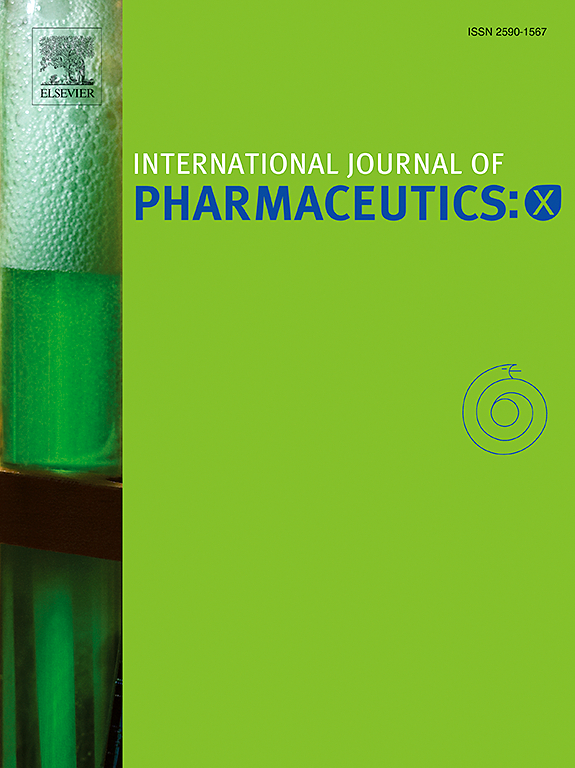用于评价多组分药物共混物粉末流动特性的实用混合模型
IF 6.4
2区 医学
Q1 PHARMACOLOGY & PHARMACY
引用次数: 0
摘要
保持药物混合物的流动性对于最先进的连续直接压缩(CDC)生产的操作效率至关重要,流动性差可能导致原料药损失,增加实验工作和延长上市时间。因此,流动性在配方设计中是一个至关重要的考虑因素,在引入变更时必须在整个开发过程中加以考虑。传统上,了解流动特性需要测试大量材料,特别是在评估配方选择时。这导致了开发预测流动模型以减少实验负担的研究。目前具有良好预测能力的模型,如使用颗粒键数,需要非常规的测量,如机械表面能。开发了三种混合设计,每种设计使用三种药物材料,以研究流动特性,并允许评估多种混合模型,以最小的实验输入要求来预测流动性。所得模型的复杂性从简单的一阶混合模型到更复杂的具有二元和三元相互作用参数的三阶模型不等。对实验成本与预测精度的分析表明,虽然更复杂的模型提供了最准确的预测,但使用反FFC的一阶质量加权模型能够提供良好的预测,以获得更易于管理的实验负担,R2值为0.68,均方根误差为2.88,平均绝对百分比误差为0.21。该模型有可能在材料稀缺和良好流动性至关重要的早期配方设计和开发中提供有价值的见解。本文章由计算机程序翻译,如有差异,请以英文原文为准。

A pragmatic mixing model for the evaluation of powder flow properties of multicomponent pharmaceutical blends
Maintaining flowability of pharmaceutical blends is critical for operational efficiency in state-of-the-art continuous direct compression (CDC) manufacturing, with poor flow potentially resulting in API loss, increased experimental work and increased time to market. Consequently, flowability is a crucial consideration in the design of formulations and must be considered throughout the development process when changes are introduced. Traditionally, understanding flow properties has required testing large amounts of material, particularly when evaluating formulation options. This has led to research into developing predictive flow models to reduce experimental burden. Current models with good predictive capacity, such as using granular bond number, require non-routine measurements such as mechanical surface energy. Three mixture designs, each using three pharmaceutical materials, were developed to investigate flow properties and allow the evaluation of a number of mixing models for predicting flowability with minimal experimental input requirements. The resultant models ranged in complexity from simple first order mixture models to more complex third order models with binary and ternary interaction parameters. An analysis of the experimental cost versus prediction accuracy suggested that while the more complex models delivered the most accurate predictions, a first order mass weighted model using inverse FFC was capable of providing good predictions in return for a more manageable experimental burden, with an R2 value of 0.68, root mean square error of 2.88 and a mean absolute percentage error of 0.21. This model has the potential to provide valuable insights during early formulation design and development where material is scarce and good flowability is crucial.
求助全文
通过发布文献求助,成功后即可免费获取论文全文。
去求助
来源期刊

International Journal of Pharmaceutics: X
Pharmacology, Toxicology and Pharmaceutics-Pharmaceutical Science
CiteScore
6.60
自引率
0.00%
发文量
32
审稿时长
24 days
期刊介绍:
International Journal of Pharmaceutics: X offers authors with high-quality research who want to publish in a gold open access journal the opportunity to make their work immediately, permanently, and freely accessible.
International Journal of Pharmaceutics: X authors will pay an article publishing charge (APC), have a choice of license options, and retain copyright. Please check the APC here. The journal is indexed in SCOPUS, PUBMED, PMC and DOAJ.
The International Journal of Pharmaceutics is the second most cited journal in the "Pharmacy & Pharmacology" category out of 358 journals, being the true home for pharmaceutical scientists concerned with the physical, chemical and biological properties of devices and delivery systems for drugs, vaccines and biologicals, including their design, manufacture and evaluation. This includes evaluation of the properties of drugs, excipients such as surfactants and polymers and novel materials. The journal has special sections on pharmaceutical nanotechnology and personalized medicines, and publishes research papers, reviews, commentaries and letters to the editor as well as special issues.
 求助内容:
求助内容: 应助结果提醒方式:
应助结果提醒方式:


